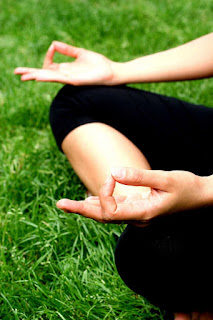Meditation and It's Benefits
Simple techniques for meditation include:
i. meditation on the breath
ii. meditation on a visualized or actual object such as an area of the body for healing, the chakras within the body, a deity, mandala, candle, yantra, or a quality such as compassion, and/or
iii. the repetition of a mantra, (a sacred sound), which can be with the use of a mala, or prayer beads.
Don't Worry About "Achieving" the Meditative State - This Occurs Naturally After Some Time
Once you are well on your way in your yoga practice and healthy in body and approach you may be able to sit still and focus your awareness on a single point. This, according to the Yoga sutras of Patanjali, will lead you spontaneously into meditation. So it is actually concentration that we sit down to practice, i.e. the continuous focus on a specific point, not meditation. Meditation is the stage that follows it.
Some Benefits of Meditation
Meditation offers a chance to bring our attention to our rich inner and outer worlds, which can have a positive effect on our health, and the way we live and see the world. As meditation can improve our ability to concentrate, to create, and to connect with our selves and our environment, it can lead to an increased sense of fulfillment.
.
During meditation body goes into a deeper state of relaxation, even more than in normal sleep. This can be seen by a decrease in the rate of breathing, metabolism, cortisol levels, and oxygen consumption, an increase in skin resistance. While when we sleep the body can move leading to muscles contraction, or tension, this does not happen in meditation as the body is still and comfortable.
.
When we are in deep rest, the parasympathetic nervous system as well as the digestive system are able to function well, therefore helping to prevent stress related illness and digestive system disorders, as well as other illnesses. Furthermore, the effects as well as the response to stress are minimised.
.
Meditation also improves brain functioning as there is greater brain wave coherence (brain waves function in a more orderly manner), according to EEG (electroencephalogram) recordings. Meditators also show a greater ability to focus attention than prior to their practice.
.
We need to be healthy enough to sit still with an upright spine in order to meditate, though if this is not possible, props can be used to help. The science of hatha yoga is designed to strengthen the body and still the mind enough so that we can do this. See Patanjali's Eight Limbs of Yoga.
Meditation should be practiced under the guidance of a qualified teacher.



